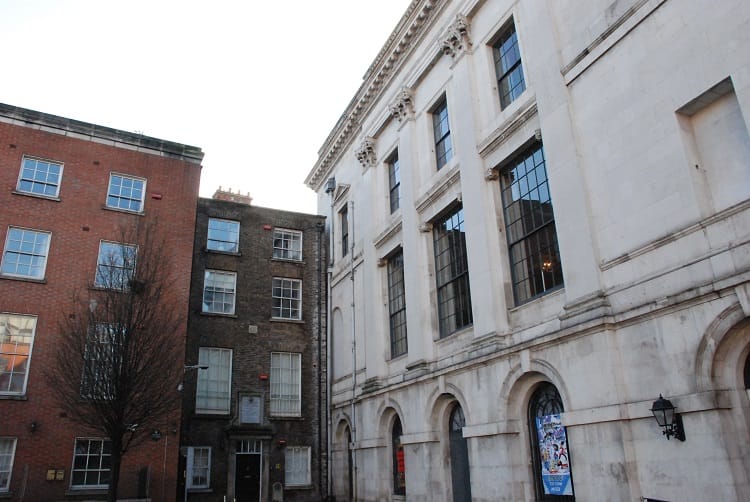What’s the best way to tell area residents about plans for a new asylum shelter nearby?
The government should tell communities directly about plans for new asylum shelters, some activists and politicians say.
Willie Halpin never changed his story about where he threw his rifle during the 1916 Rising. But council officials don’t want to look there.

As snipers took aim, Willie Halpin took to the fireplace.
An Irish Citizen Army member, Halpin left his house in North Wall on Monday morning as the Rising commenced, and was stationed at City Hall during the rebellion.
By Tuesday morning his garrison was overrun. To evade capture, Halpin hid up the chimney, according to local history group East Wall For All.
There he remained for two days undetected – and unarmed.
Earlier, Halpin had supposedly thrown his rifle from the roof down a narrow gap between City Hall and No. 1 Exchange Court next door.
Independent Councillor Nial Ring is on a mission to find it.

North Wall to City Hall
Halpin was among the first to sign up for the newly formed Irish Citizen Army (ICA) in 1913.
The dockworker replaced playwright Sean O’Casey on the ICA’s executive council after O’Casey left over internal disagreements.
According to East Wall For All, Halpin was seen by fellow ICA members as something of a mascot rather than a leader, a figure of fun because of his small stature.
On Easter Monday morning, Halpin left his house at 6 Valentine Terrace with a Boer Mauser rifle. As British troops closed in on City Hall later that day, his garrison came under intense fire.
Halpin’s commander, Sean Connolly, was shot by a sniper as the garrison retreated to the roof. His replacement, Sean O’Reilly, was killed soon after, according to Joseph McKenna’s Voices from the Easter Rising: Firsthand Accounts of Ireland’s 1916 Rebellion.
Before retreating to the fireplace in what is now the Richard O’Carroll Room at City Hall, Halpin threw his rifle off the roof, and it fell down a small void between City Hall and Exchange Place.
At least that’s what Halpin told his family.
In March, Councillor Ring asked that Dublin City Council look at whether it would be possible to excavate the spot where Halpin is supposed to have thrown his gun.
“He always told his family that he threw his rifle away down that gap,” says Ring. “He never changed his story on that.”
East Wall historian Joe Mooney agrees. He met with Halpin’s relatives, including his grandson, Colm, who died last year, and says he thinks it’s worth trying to retrieve Halpin’s rifle.
“In reality it’s a very small location that needs to be searched,” Mooney says.
But the council is not convinced.
On the back of Ring’s request, City Archaeologist Ruth Johnson and built-heritage archaeologist Franc Myles conducted a desktop report into Halpin’s rifle and its possible retrieval.
The gap down which Halpin is said to have dropped his rifle measures 11 inches in width. There’s a cast-iron drain pipe in the way at the moment, which would need to be removed before further investigation, the report notes.
For this story to be true, though, Halpin had to be on the roof of City Hall during the fighting, the report notes.
He’d also have had to climb over the building’s balustrade, avoiding British snipers, and drop his rifle under the overhang.
Because the roof of City Hall overhangs “it would thus have been difficult to have deposited the rifle from above, unless it was dropped from the roof of the adjoining building”, the report notes.
“It would appear unlikely that Halpin would have been able to dispose of the rifle in the fashion suggested,” the report continues.
But, as Ring sees it, there’s only one way to be sure.
Halpin was subsequently interred at Frongoch prison camp, in Wales, for his part in 1916. He went on to fight in the War of Independence, and took the anti-Treaty side during the Civil War. He died in 1951.
In his later years, according to East Wall’s Mooney, Halpin and his family gathered around a flagpole in their front garden every Easter to honour the dead.
Members of the City Hall garrison – Dr Kathleen Lynn, for instance – went on to play important roles post 1916, says Mooney. “In the story of 1916 it was a very important garrison,” he says. “The rifle is very much part of the story. It would be great to find it.”
Even if Halpin’s rifle tale is apocryphal, the council doesn’t seem keen to find out for sure, says Ring.
Last week, the council Chief Executive Owen Keegan told Ring that excavating the site could cost €4,150. Excavation also requires cross-council departmental coordination, which, in time and cost, is likely to be considerable, said Keegan.
Ring hopes his area’s discretionary fund – an annual pot of money for each area of the city that councillors decide how to spend – can cover the costs of excavation. “We’re kind of taking it on ourselves,” says Ring. “It would be a magnificent centrepiece to have at City Hall.”
Weapons from the Rising are tricky, the council’s report notes. The paperwork for their disposal become so muddled after the Rising that they’re hard to authenticate.
If Halpin’s story is true and the rifle is retrieved, the report notes, “it would be one of the few weapons associated with 1916 to enjoy an impeccable provenance”.